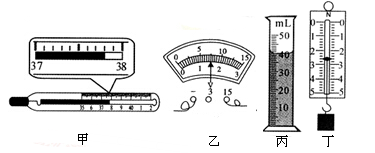如图是四种仪器的测量情形。

(1)图甲中体温计的读数为_ _℃;
(2)图乙中电压表的示数为_ __V;
(3)图丙量筒中液体的体积为_ __mL;
(4)图丁中弹簧测力计的示数为_ _N。
(1)37 .8; (2)7.5 ; (3)40;(4)2.6
题目分析:(1)体温计的分度值为0.1℃,所以图示体温计的示数为37.8℃;(2)电压表选0—15v量程时,分度值为0.5v,所以图示电压表的示数为7.5V;(3)读量筒的示数时,视线要与水面的凹面相平,所以为40mL;(4)弹簧测力计的分度值为0.2N,所以示数为2.6N。
